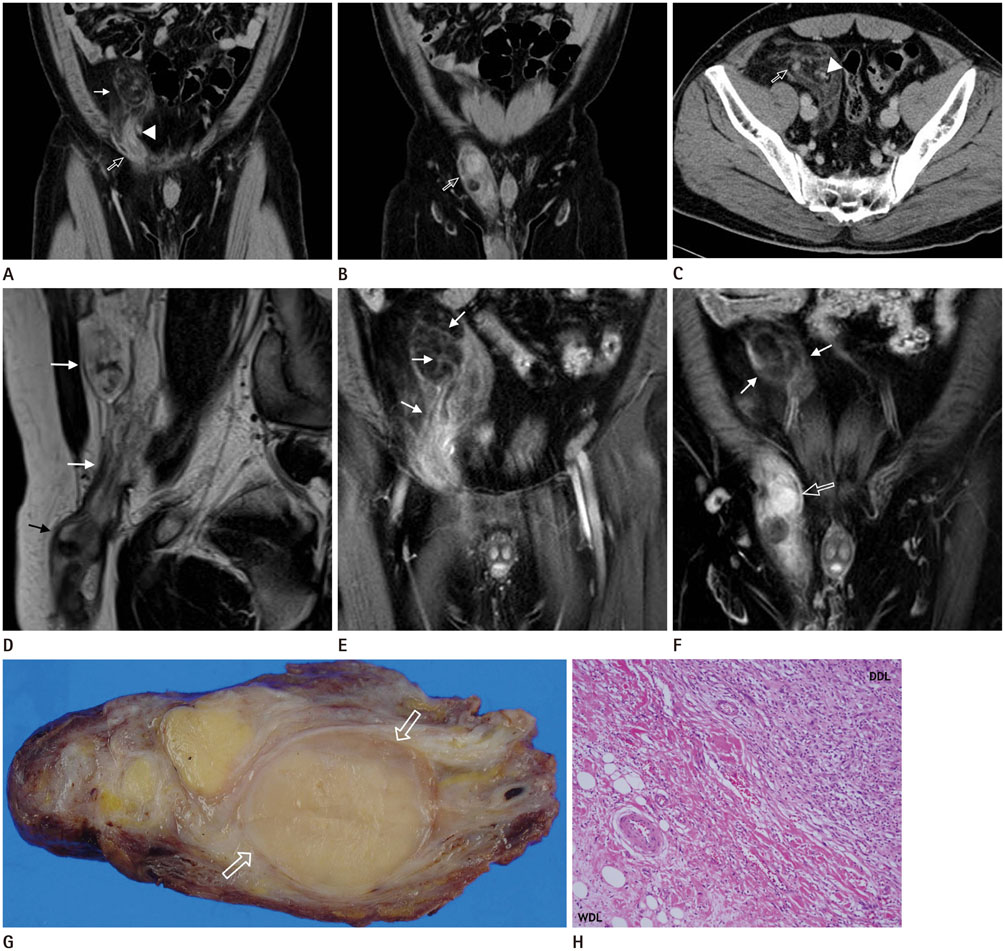J Korean Soc Radiol.
2016 Jan;74(1):66-70. 10.3348/jksr.2016.74.1.66.
Dedifferentiated Retroperitoneal Liposarcoma Presenting as Right Inguinal Hernia: A Case Report
- Affiliations
-
- 1Department of Radiology, Uijeongbu St. Mary's Hospital, College of Medicine, The Catholic University of Korea, Uijeongbu, Korea. ymiku@catholic.ac.kr
- 2Department of Radiology, Seoul St. Mary's Hospital, College of Medicine, The Catholic University of Korea, Seoul, Korea.
- KMID: 2150465
- DOI: http://doi.org/10.3348/jksr.2016.74.1.66
Abstract
- Retroperitoneal liposarcomas usually present as painless, slow-growing abdominal masses. When masses grow large enough to compress surrounding structures, symptoms may occur. Retroperitoneal liposarcoma clinically manifesting as inguinal hernia is a very rare entity; only 11 cases have been reported. Herein, we present radiographic features of a 37-year-old male with a painless palpable mass in the right groin that was identified as dedifferentiated retroperitoneal liposarcoma herniated through the right inguinal canal.
MeSH Terms
Figure
Reference
-
1. Hong SH, Kim KA, Woo OH, Park CM, Kim CH, Kim MJ, et al. Dedifferentiated liposarcoma of retroperitoneum: spectrum of imaging findings in 15 patients. Clin Imaging. 2010; 34:203–210.2. Mizuno Y, Sumi Y, Nachi S, Ito Y, Marui T, Saji S, et al. A case of a large retroperitoneal liposarcoma presenting as an incarcerated inguinal hernia. Hernia. 2006; 10:439–442.3. McKinley SK, Abreu N, Patalas E, Chang A. Large Retroperitoneal Liposarcoma Diagnosed upon Radiological Evaluation of Mild Right-Sided Inguinal Hernia. Case Rep Radiol. 2013; 2013:187957.4. Vagnoni V, Brunocilla E, Schiavina R, Borghesi M, Passaretti G, Gentile G, et al. Inguinal canal tumors of adulthood. Anticancer Res. 2013; 33:2361–2368.5. Lahat G, Anaya DA, Wang X, Tuvin D, Lev D, Pollock RE. Resectable well-differentiated versus dedifferentiated liposarcomas: two different diseases possibly requiring different treatment approaches. Ann Surg Oncol. 2008; 15:1585–1593.6. Tateishi U, Hasegawa T, Beppu Y, Satake M, Moriyama N. Primary dedifferentiated liposarcoma of the retroperitoneum. Prognostic significance of computed tomography and magnetic resonance imaging features. J Comput Assist Tomogr. 2003; 27:799–780.7. Song T, Shen J, Liang BL, Mai WW, Li Y, Guo HC. Retroperitoneal liposarcoma: MR characteristics and pathological correlative analysis. Abdom Imaging. 2007; 32:668–674.8. Nishino M, Hayakawa K, Minami M, Yamamoto A, Ueda H, Takasu K. Primary retroperitoneal neoplasms: CT and MR imaging findings with anatomic and pathologic diagnostic clues. Radiographics. 2003; 23:45–57.9. Aikawa H, Tanoue S, Okino Y, Tomonari K, Miyake H. Pelvic extension of retroperitoneal fluid: analysis in vivo. AJR Am J Roentgenol. 1998; 171:671–677.10. Aguirre DA, Santosa AC, Casola G, Sirlin CB. Abdominal wall hernias: imaging features, complications, and diagnostic pitfalls at multi-detector row CT. Radiographics. 2005; 25:1501–1520.
- Full Text Links
- Actions
-
Cited
- CITED
-
- Close
- Share
- Similar articles
-
- A Case of Dedifferentiated LiposarcomaThat Developed in the Dermis
- Dedifferentiated Liposarcoma of the Retroperitoneum: A case report
- Dedifferentiated Liposarcoma with a Peculiar Whorling Pattern: A Case Report
- Dedifferentiated Liposarcoma in the Thigh: Case Report
- Imaging Findings of Scrotal Liposarcoma: A Case Report


